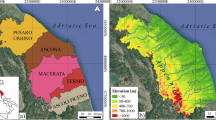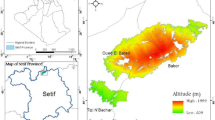Abstract
Solar radiation is the main responsible of many processes of the biophysical environment. Temperature changes, snow melt dynamics, carbon sequestration, evaporation from soils, plants, and open water bodies are explained by the amount of radiation received in a surface. Lack of direct observations and insufficient record length limit the ability to use global solar radiation information for resource use management and planning. Based on the general equation of Bristow and Campbell, we propose a modification that allows us to better represent atmospheric transmissivity as a function of routine meteorological variables and improve estimates of global solar radiation in Mediterranean and semi arid areas. The improved Bristow-Campbell model (IBC) is easy to use in any location where measurements of temperature, precipitation, and relative humidity are available, and present a simple solution that can be used as proxy for relative humidity in case that variable is not been measured.


Similar content being viewed by others
References
Allen R (1997) Self-calibrating method for estimating solar radiation from air temperature. J Hydrol Eng 2:56–57
Angström A (1924) Solar and terrestrial radiation. QJR Meteorol Soc 50:121–125
Bindi M, Miglietta F (1991) Estimating daily global radiation from air temperature and rainfall measurements. Clim Res 1:117–124
Bristow K, Campbell G (1984) On the relationship between incoming solar radiation and daily maximum and minimum temperature. Agric For Meteorol 31:159–166
Brooks FA (1959) An introduction of physical microclimatology. Univ. of California, Davis, p 264
Campbell SG, Norman JL (1998) An introduction to environmental biophysics, 2nd edn. Springer, New York
Colle S, De Abreu SL, Ruther R (2001) Uncertainty in economic analysis of solar water heating and photovoltaic systems. Sol Energy 70(2):131–142
Coops NC, Waring RH, Moncrieff JB (2000) Estimating mean monthly incident solar radiation on horizontal and inclined slopes from mean monthly temperatures extremes. Int J Biometeorol 44:204–211
Dubayah RC (1994) Modeling a solar radiation topo-climatology for the Rio Grande River basin. J Veg Sci 5:627–640
Georgiev A, Roth P, Olivares A (2004) Sun following system adjustment at the UTFSM. Energ Convers Manage 45:1795–1806
Kilic A, Öztürk A (1983) Güneş Enerjisi. Kipaş Dağıtımcılık, İstanbul
Klein SA (1977) Calculation of monthly average insolation on tilted surfaces. Sol Energy 19:325–329
Krikova NA, Solanski SK (2004) Solar variability and global warming: a statistical comparison since 1850. Adv Space Res 34:361–364
Meza F, Varas E (2000) Estimation of mean monthly solar global radiation as a function of temperature. Agric For Meteorol 100:231–241
Myers DR (2005) Solar radiation modeling and measurements for renewable energy applications: data and model quality. Energy 30:1517–1531
Peel MC, Finlayson BL, McMahon TA (2007) Updated world map of the Koppen-Geiger climate classification. Hydrol Earth Syst Sci 11(5):1633–1644
Romo J, Arteaga R (1983) Meteorología Aplicada. Universidad Autónoma de Chapingo. 442 pp
Salima G, Chavula GMS (2012) Determining angstrom constants for estimating solar radiation in Malawi. Int J Geosci 3:391–397
Spencer JW (1971) Fourier series representation of the position of the Sun. Search 2(5):172
Thorton PE, Running SW (1999) An improved algorithm for estimating incident daily solar radiation from measurements of temperature, humidity and precipitation. Agric For Meteorol 93:211–228
Vecam D (2011) Measurement and comparison of solar radiatoion estimation for Izmir/Turkey. Izmir Institute of Technology Case. Master of Science, Izmir Institute of Technology
Woodwell GM (1967) Radiation and the patterns of nature. Science 156:461–470
Acknowledgments
This work has been supported by FONDECYT grant 1120713. María Lorenzo would like to thank Jose Luis Rodriguez Gil (University of Guelph) for valuable advice and revision of an early version of this manuscript.
Author information
Authors and Affiliations
Corresponding author
Rights and permissions
About this article
Cite this article
Meza, F.J., Yebra, M.L. Estimation of daily global solar radiation as a function of routine meteorological data in Mediterranean areas. Theor Appl Climatol 125, 479–488 (2016). https://doi.org/10.1007/s00704-015-1519-6
Received:
Accepted:
Published:
Issue Date:
DOI: https://doi.org/10.1007/s00704-015-1519-6




